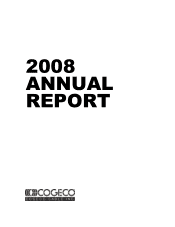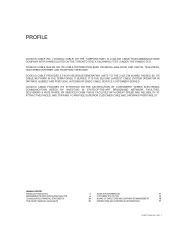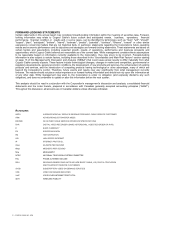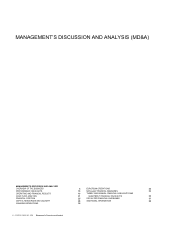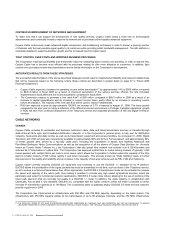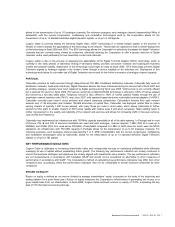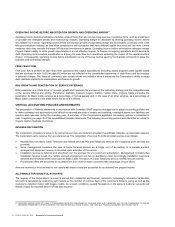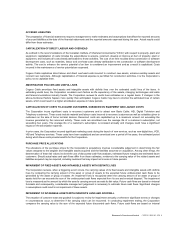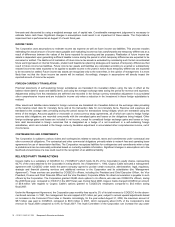Cogeco 2008 Annual Report Download - page 9
Download and view the complete annual report
Please find page 9 of the 2008 Cogeco annual report below. You can navigate through the pages in the report by either clicking on the pages listed below, or by using the keyword search tool below to find specific information within the annual report.
8 COGECO CABLE INC. 2008 Management’s Discussion and Analysis
OPERATING INCOME BEFORE AMORTIZATION GROWTH AND OPERATING MARGIN(1)
Operating income before amortization excludes unusual items that are non-recurring revenue or expense items, such as impairment
of goodwill and intangible assets and restructuring charges. Operating margin is calculated by dividing operating income before
amortization by revenue. Operating income before amortization growth and operating margin are benchmarks commonly used in the
telecommunications industry, as they allow comparisons with companies that have different capital structures and are more current
measures since they exclude the impact of historical investments in assets. Operating income before amortization indicators assess
Cogeco Cable’s ability to seize growth opportunities in a cost effective manner, to finance its ongoing operations and to service its
debt. Operating income before amortization is a proxy for cash flow from operations excluding the impact of the capital structure
chosen. Consequently, operating income before amortization is one of the key metrics used by the financial community to value the
business and its financial strength.
FREE CASH FLOW
Free cash flow is defined as cash flows from operations less capital expenditures (including assets acquired under capital leases
that are disclosed in note 16 B) on page 65, which are not reflected in the consolidated statements of cash flows) and the increase
in deferred charges. The financial community also closely follows this indicator since it measures the Corporation’s ability to repay
debt, distribute capital to its shareholders and finance its growth.
RGU GROWTH AND PENETRATION OF SERVICE OFFERINGS
RGU expansion is a critical driver of revenue growth and measures the success of the marketing strategy and the competitiveness
of the service offering and pricing. Penetration statistics measure Cogeco Cable’s market share. Cogeco Cable computes the
penetration for Basic Cable services as a percentage of homes passed and, in the case of all other services, as a percentage of
Basic Cable customers in the areas where the service is offered.
CRITICAL ACCOUNTING POLICIES AND ESTIMATES
The preparation of financial statements in accordance with Canadian GAAP requires management to adopt accounting policies and
to make estimates and assumptions that affect the reported amounts of assets and liabilities, contingent assets and liabilities and
revenue and expenses during the reporting year. A summary of the Corporation’s significant accounting policies is presented in
note 1 beginning on page 45 of the consolidated financial statements. The following accounting policies were identified as critical to
Cogeco Cable’s business operations:
REVENUE RECOGNITION
The Corporation considers revenue to be earned as services are rendered, provided that ultimate collection is reasonably assured.
The Corporation earns revenue from several sources. The recognition of revenue from the principal sources is as follows:
• Monthly fees from Basic Cable Television and related services, HSI and Telephony services are recognized when services are
provided;
• Since management considers the sale of home terminal devices as a single unit of accounting of a multiple element
arrangement, equipment revenue is recorded upon activation of the service;
• Installation revenue is deferred and amortized over the average life of a customer’s subscription. Management considers that
installation revenue is part of a multiple element arrangement and has no standalone value. Accordingly, installation revenue is
deferred and amortized at the same pace as Basic Cable Television, HSI and Telephony service monthly fees are earned;
• Promotional offers are accounted for as deductions from revenue when customers take advantage of such offers.
Amounts received or invoiced that do not comply with these criteria are accounted for as deferred and prepaid income.
ALLOWANCE FOR DOUBTFUL ACCOUNTS
The majority of the Corporation’s revenue is earned from residential and business customers. Accordingly, allowance for doubtful
accounts is calculated by examining such factors as the number of overdue days of the customer’s balance owing as well as the
customer’s collection history with Cogeco Cable. As a result, conditions causing fluctuations in the aging of customer accounts will
directly impact the reported amount of bad debt expense.
(1) OPERATING MARGIN DOES NOT HAVE A STANDARDIZED DEFINITION PRESCRIBED BY CANADIAN GAAP AND THEREFORE, MAY NOT BE COMPARABLE TO SIMILAR
MEASURES PRESENTED BY OTHER COMPANIES. FOR FURTHER DETAILS, PLEASE CONSULT THE “NON-GAAP FINANCIAL MEASURES” SECTION ON PAGE 33.

